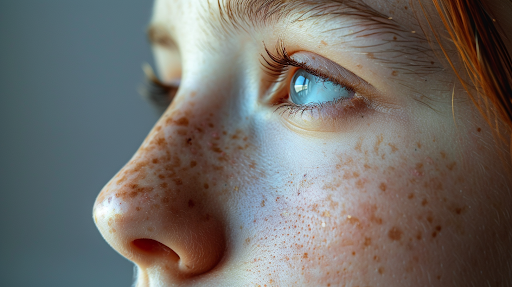The nose stands as a central feature of the face, influencing facial symmetry and overall aesthetic appeal. For individuals seeking a refined and pointy nose, the options extend from surgical to non-surgical interventions. Rhinoplasty, commonly referred to as a nose job, is a surgical procedure aimed at reshaping the nasal structures to achieve desired aesthetics and functionality.
On the other hand, non-surgical techniques such as dermal fillers offer alternatives for those hesitant about undergoing invasive procedures. In this comprehensive guide, we delve into the various methods, considerations, and factors associated with attaining a pointy nose, catering to both surgical and non-surgical preferences.
Why Do People Want a Pointy Nose?
Preferred nose shapes are completely down to personal preference, whilst some people prefer a prominent nose, others prefer a dainty and pointy nose trait. Whether seeking to address genetic traits or align with evolving cosmetic trends, the desire for a pointy nose reflects a multifaceted journey of self-expression and identity:
- Aesthetic Preference: Many individuals desire a pointy nose due to personal aesthetic preferences and cultural beauty standards, seeking a more defined and elegant nasal contour.
- Correction of Bulbous Nose: People with a bulbous nose may seek a pointy nose to address this common nasal shape concern and achieve a more refined appearance.
- Improvement in Quality of Life: For some, the desire for a pointy nose is not solely cosmetic but also related to improving self-confidence and medical problems such as breathing issues.
- Cosmetic Surgery Trends: Trends in cosmetic surgery often influence people’s desires for specific nasal shapes, with a pointy nose being a sought-after feature in many communities.
- Genetic Factors and Nasal Structure: Genetic predispositions and underlying structures, such as lateral cartilages and nasal humps, can contribute to a desire for a pointy nose as individuals seek to harmonize their facial features and address inherited traits.
Contact a head and neck surgeon practicing in facial plastic surgery
Rhinoplasty: Surgical Approaches and Techniques
Rhinoplasty, a cosmetic surgical procedure, involves altering the nasal structures to enhance facial harmony and correct nasal deformities. The procedure can be categorized into open and closed rhinoplasty, depending on the access to the nasal structures during surgery.
- Open Rhinoplasty: In this approach, an incision is made across the columella, the strip of tissue separating the nostrils. This allows the surgeon greater visibility and access to the nasal structures, facilitating precise adjustments.
- Closed Rhinoplasty: Contrarily, closed rhinoplasty involves incisions made inside the nostrils, thereby leaving no visible external scars. While it offers limited visibility, it’s suitable for minor adjustments and requires less downtime compared to open rhinoplasty.
The Rhinoplasty Process
The rhinoplasty process is a transformative journey that begins with a comprehensive consultation, where patients discuss goals and expectations with their surgeon. From surgical planning to post-operative care, each step is meticulously tailored to achieve the desired nasal refinement, ensuring optimal results and patient satisfaction:
- Consultation: During the initial consultation, the surgeon evaluates the patient’s nasal anatomy, discusses goals and expectations, and outlines the surgical plan.
- Surgical Procedure: Depending on the chosen technique, rhinoplasty may involve reshaping nasal bones, cartilage, or tissue to achieve the desired outcome.
- Aftercare: Following surgery, patients receive comprehensive aftercare instructions, including wound care, activity restrictions, and follow-up appointments to monitor healing progress.
How To Decide If Rhinoplasty Surgery is Right For You
Several factors come into play when considering rhinoplasty, here are the factors you should consider to decide if it is the right choice for you:
- Aesthetic Preferences: Patients often have specific desires regarding their ideal nose shape, whether it’s achieving a pointy nose or addressing a bulbous tip.
- Functional Issues: Beyond aesthetics, rhinoplasty can also improve nasal breathing and alleviate issues such as a deviated septum or nasal obstruction.
- Medical Reasons: Some individuals undergo rhinoplasty to correct congenital defects, injuries, or breathing difficulties caused by structural abnormalities.
- Personal Decisions: Ultimately, the decision to undergo rhinoplasty is deeply personal and should be made after thorough consideration and consultation with a qualified surgeon.
How to make my face more symmetrical
Non-Surgical Methods for Nose Enhancement
In addition to surgical rhinoplasty, non-surgical alternatives offer temporary solutions for nose reshaping. Non-surgical methods offer a non-invasive approach to enhancing facial features, particularly the nose, through cosmetic procedures like injectable fillers.
- Injectable Fillers: Dermal fillers, such as hyaluronic acid, can be strategically injected to augment the nasal bridge or refine the nasal tip, creating the illusion of a pointy nose. A liquid nose job
- Liquid Nose Job: This non-surgical approach involves using injectable fillers to camouflage imperfections or asymmetries, providing instant results with minimal downtime.
Learn more about non-surgical nose jobs
Who Are The Ideal Candidates For Non-Surgical Nose Reshaping?
Ideal candidates for non-surgical nose reshaping are patients with minor nasal imperfections seeking non-invasive alternatives to traditional rhinoplasty procedures. Factors include minor aesthetic concerns, a preference for non-invasive methods, realistic expectations, and good overall health. This approach offers a safe and effective way to enhance nasal appearance without surgery.
- Minor Aesthetic Concerns: Ideal candidates have minor aesthetic concerns about their nasal appearance, such as a dorsal hump, asymmetry, or a desire for subtle augmentation.
- Desire for Non-Invasive Solutions: They prefer non-surgical methods to address their concerns, avoiding the downtime and potential risks associated with invasive procedures.
- Realistic Expectations: Candidates understand the limitations of non-surgical nose reshaping and have realistic expectations about the results achievable through injectable fillers.
- Good Overall Health: They are in good overall health, with no contraindications to receiving injectable treatments, ensuring a safe and successful procedure.
Medispa and Surgery Clinic in Montreal
At Clinique Face MD, our team of head and neck surgeons practicing in facial plastic surgery are renowned for their commitment to excellence. With a passion for aesthetic refinement, our surgeons deliver natural-looking results tailored to each patient’s unique needs. From rhinoplasty procedures to facial rejuvenation techniques, we work alongside you to enhance your beauty and restore your confidence.





